Zara's International Business: Strategies, FDI, and Challenges Report
VerifiedAdded on 2020/01/28
|20
|3897
|272
Report
AI Summary
This report provides an in-depth analysis of Zara's international business operations. It begins with an executive summary defining international business and highlighting the importance of effective resource management in global operations. The report uses Zara, a leading high-end fashion retailer, as a case study to examine the challenges and successes of international expansion. The methodology includes primary and secondary research, focusing on key areas such as Foreign Direct Investment (FDI), international trade theory, international strategy, cultural differences, and ethics and corporate social responsibility. Findings reveal Zara's strategic use of FDI for global expansion, including mergers, acquisitions, and joint ventures. The report explores Zara's application of international trade theories like free trade and specialization, and its innovative business model. It also analyzes Zara's international strategy, using models like Bartlett and Ghoshal to assess its efficiency, knowledge leverage, and responsiveness. The report addresses the level of adaptation and standardization across its global operations, and concludes with an overview of Zara's CSR and ethical considerations within its international business framework, including ethical theories and sustainability models.
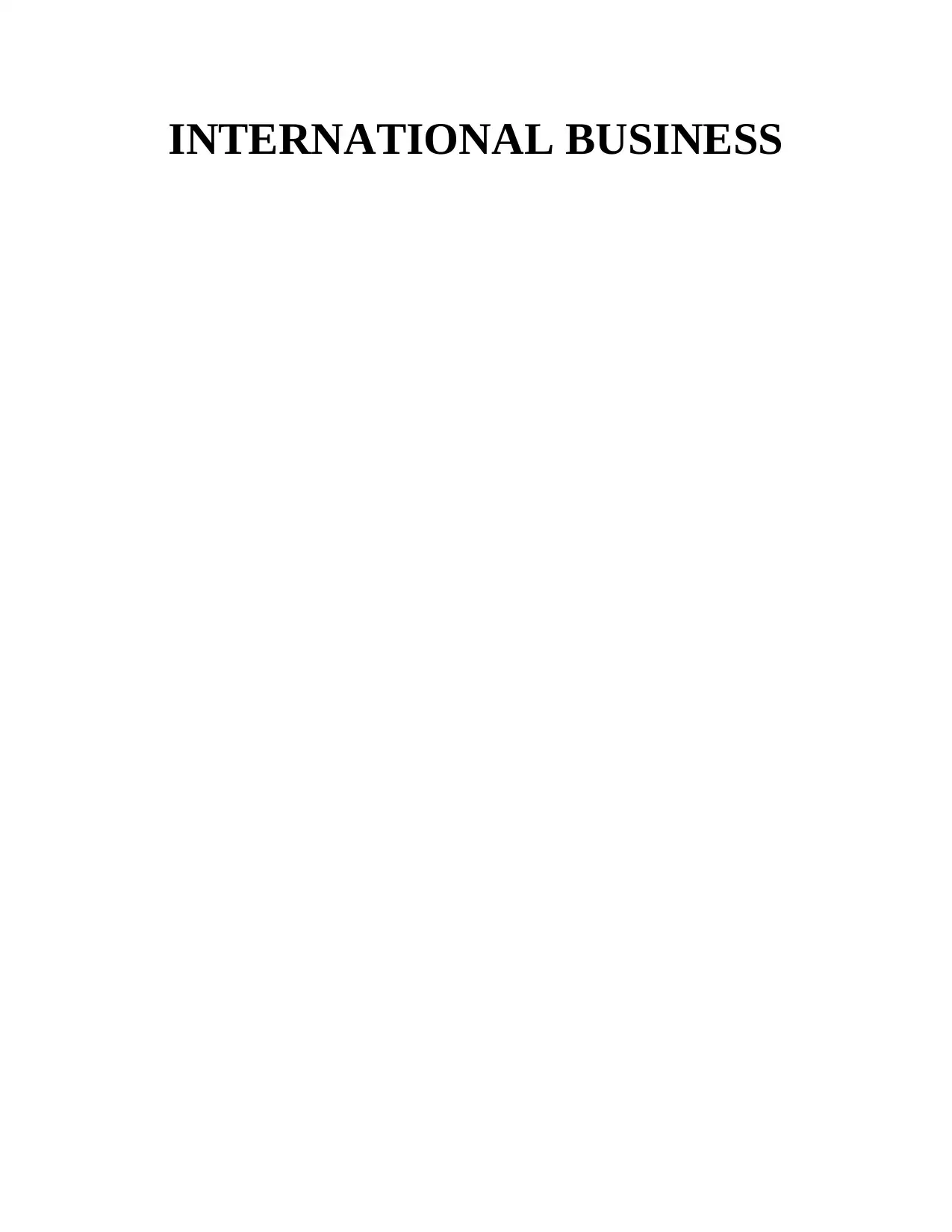
INTERNATIONAL BUSINESS
Paraphrase This Document
Need a fresh take? Get an instant paraphrase of this document with our AI Paraphraser
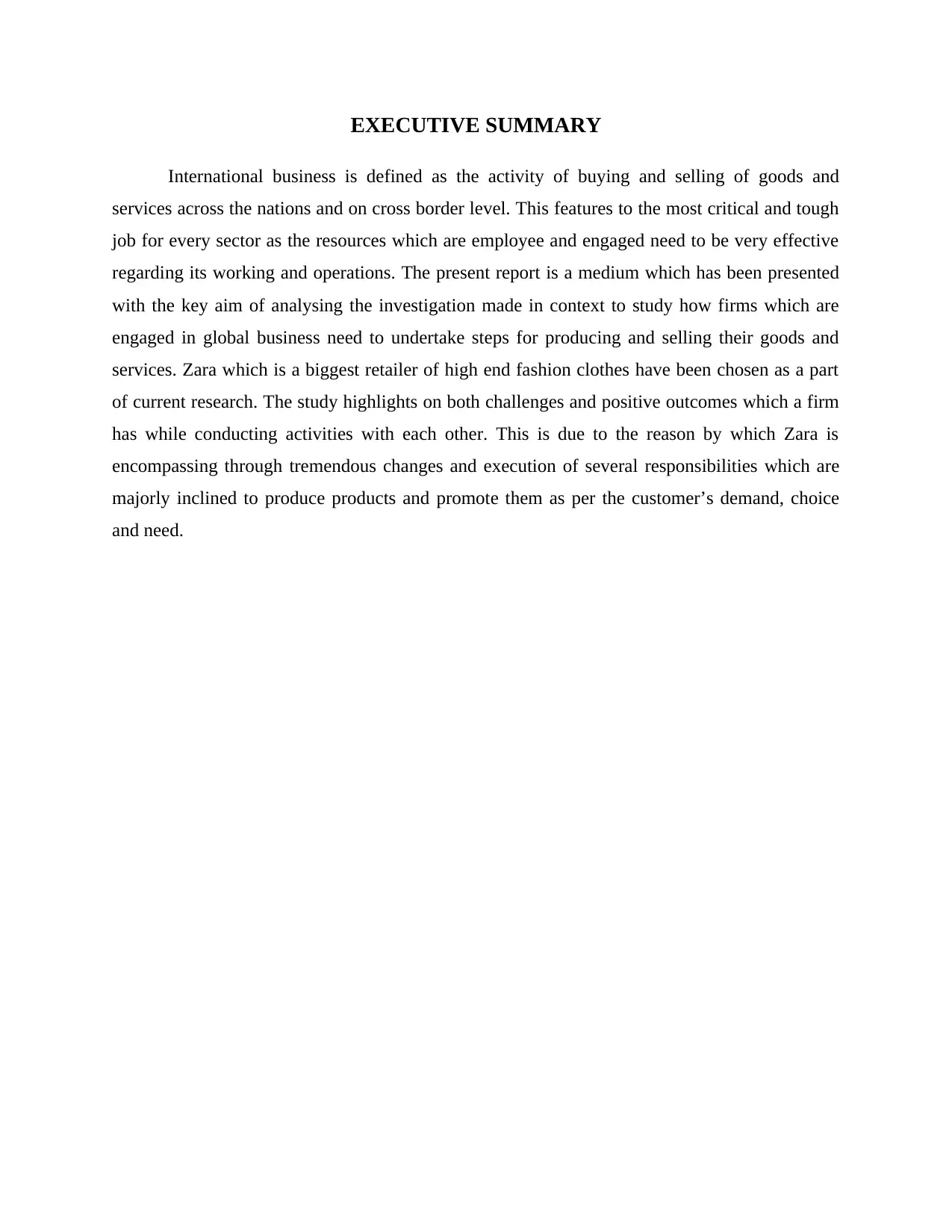
EXECUTIVE SUMMARY
International business is defined as the activity of buying and selling of goods and
services across the nations and on cross border level. This features to the most critical and tough
job for every sector as the resources which are employee and engaged need to be very effective
regarding its working and operations. The present report is a medium which has been presented
with the key aim of analysing the investigation made in context to study how firms which are
engaged in global business need to undertake steps for producing and selling their goods and
services. Zara which is a biggest retailer of high end fashion clothes have been chosen as a part
of current research. The study highlights on both challenges and positive outcomes which a firm
has while conducting activities with each other. This is due to the reason by which Zara is
encompassing through tremendous changes and execution of several responsibilities which are
majorly inclined to produce products and promote them as per the customer’s demand, choice
and need.
International business is defined as the activity of buying and selling of goods and
services across the nations and on cross border level. This features to the most critical and tough
job for every sector as the resources which are employee and engaged need to be very effective
regarding its working and operations. The present report is a medium which has been presented
with the key aim of analysing the investigation made in context to study how firms which are
engaged in global business need to undertake steps for producing and selling their goods and
services. Zara which is a biggest retailer of high end fashion clothes have been chosen as a part
of current research. The study highlights on both challenges and positive outcomes which a firm
has while conducting activities with each other. This is due to the reason by which Zara is
encompassing through tremendous changes and execution of several responsibilities which are
majorly inclined to produce products and promote them as per the customer’s demand, choice
and need.
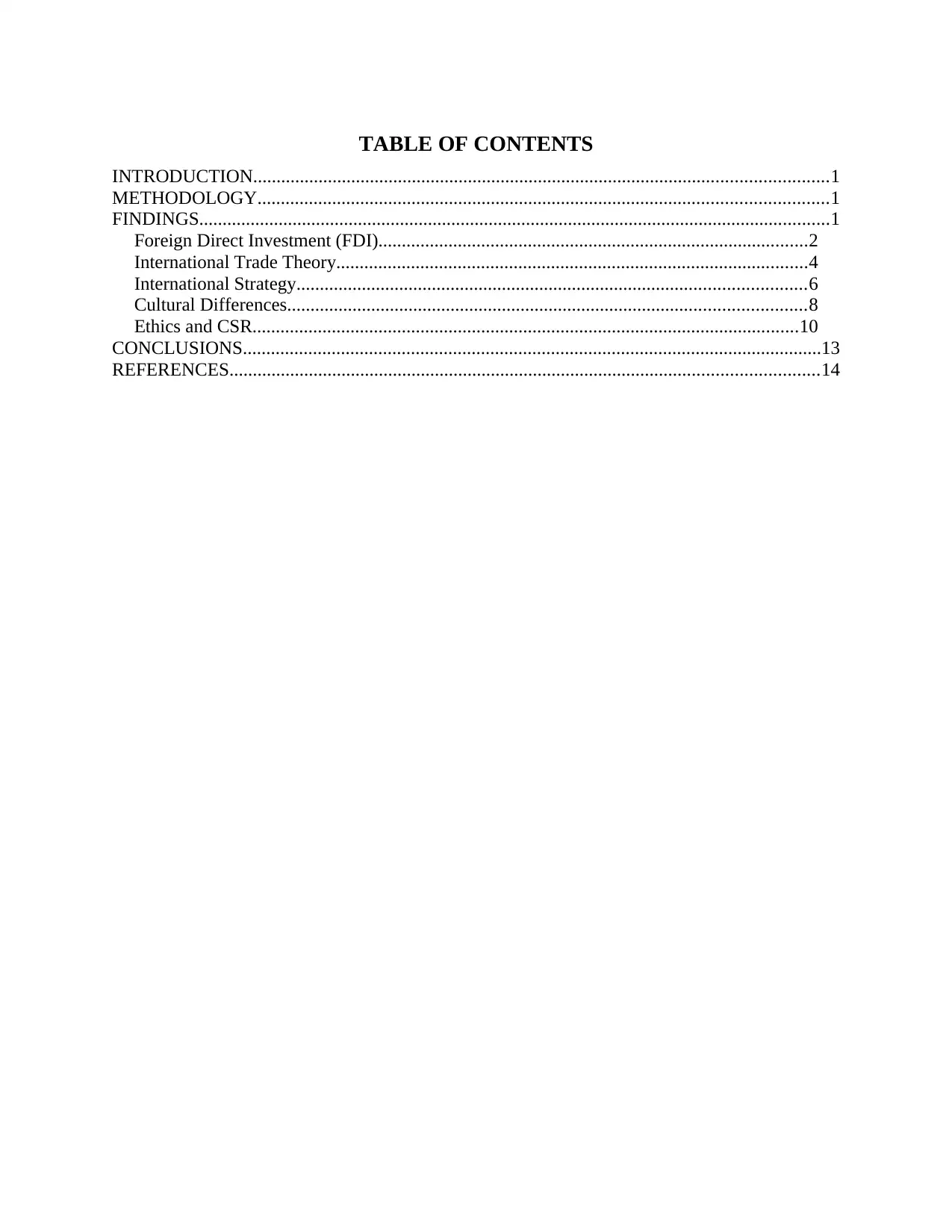
TABLE OF CONTENTS
INTRODUCTION...........................................................................................................................1
METHODOLOGY..........................................................................................................................1
FINDINGS.......................................................................................................................................1
Foreign Direct Investment (FDI)............................................................................................2
International Trade Theory.....................................................................................................4
International Strategy.............................................................................................................6
Cultural Differences...............................................................................................................8
Ethics and CSR.....................................................................................................................10
CONCLUSIONS............................................................................................................................13
REFERENCES..............................................................................................................................14
INTRODUCTION...........................................................................................................................1
METHODOLOGY..........................................................................................................................1
FINDINGS.......................................................................................................................................1
Foreign Direct Investment (FDI)............................................................................................2
International Trade Theory.....................................................................................................4
International Strategy.............................................................................................................6
Cultural Differences...............................................................................................................8
Ethics and CSR.....................................................................................................................10
CONCLUSIONS............................................................................................................................13
REFERENCES..............................................................................................................................14
⊘ This is a preview!⊘
Do you want full access?
Subscribe today to unlock all pages.

Trusted by 1+ million students worldwide
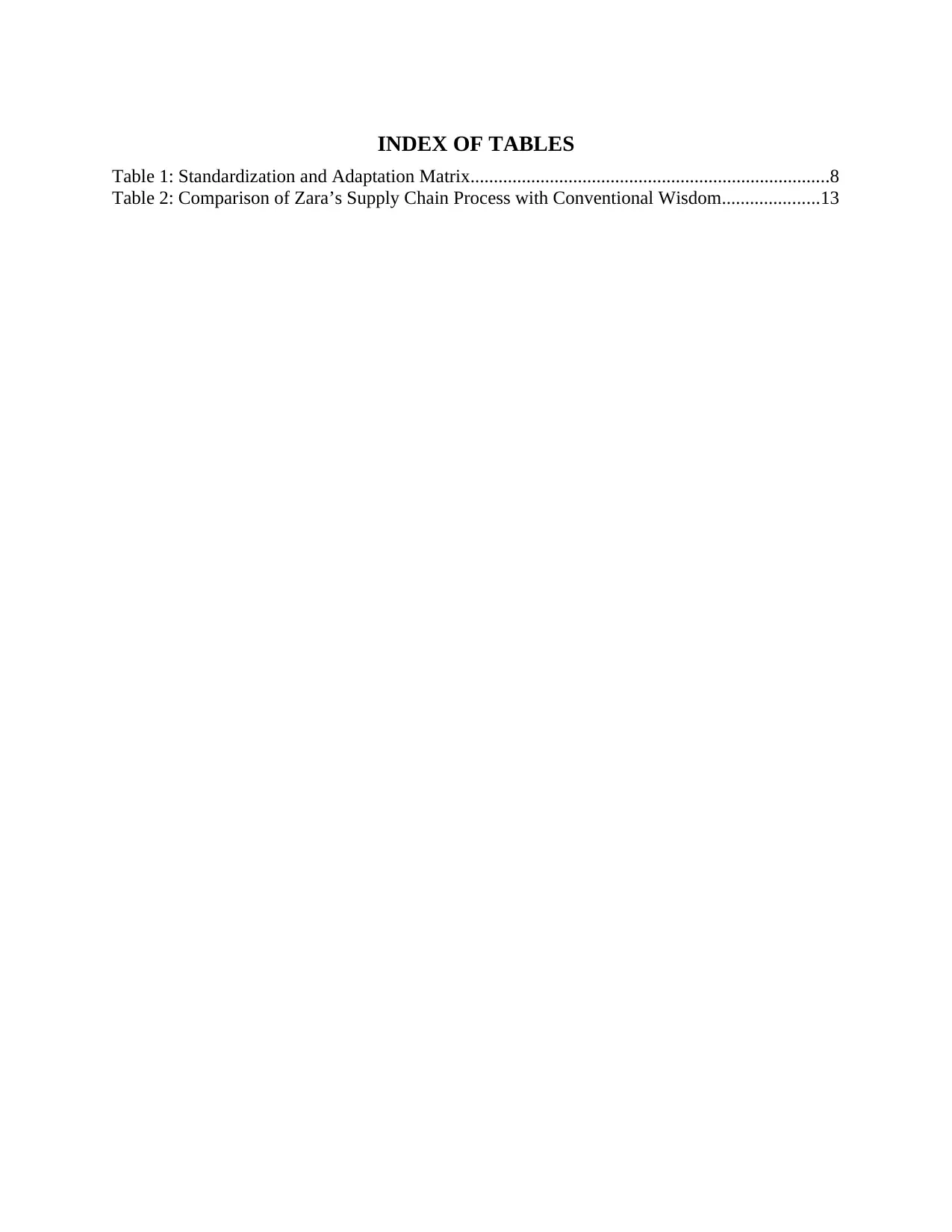
INDEX OF TABLES
Table 1: Standardization and Adaptation Matrix.............................................................................8
Table 2: Comparison of Zara’s Supply Chain Process with Conventional Wisdom.....................13
Table 1: Standardization and Adaptation Matrix.............................................................................8
Table 2: Comparison of Zara’s Supply Chain Process with Conventional Wisdom.....................13
Paraphrase This Document
Need a fresh take? Get an instant paraphrase of this document with our AI Paraphraser
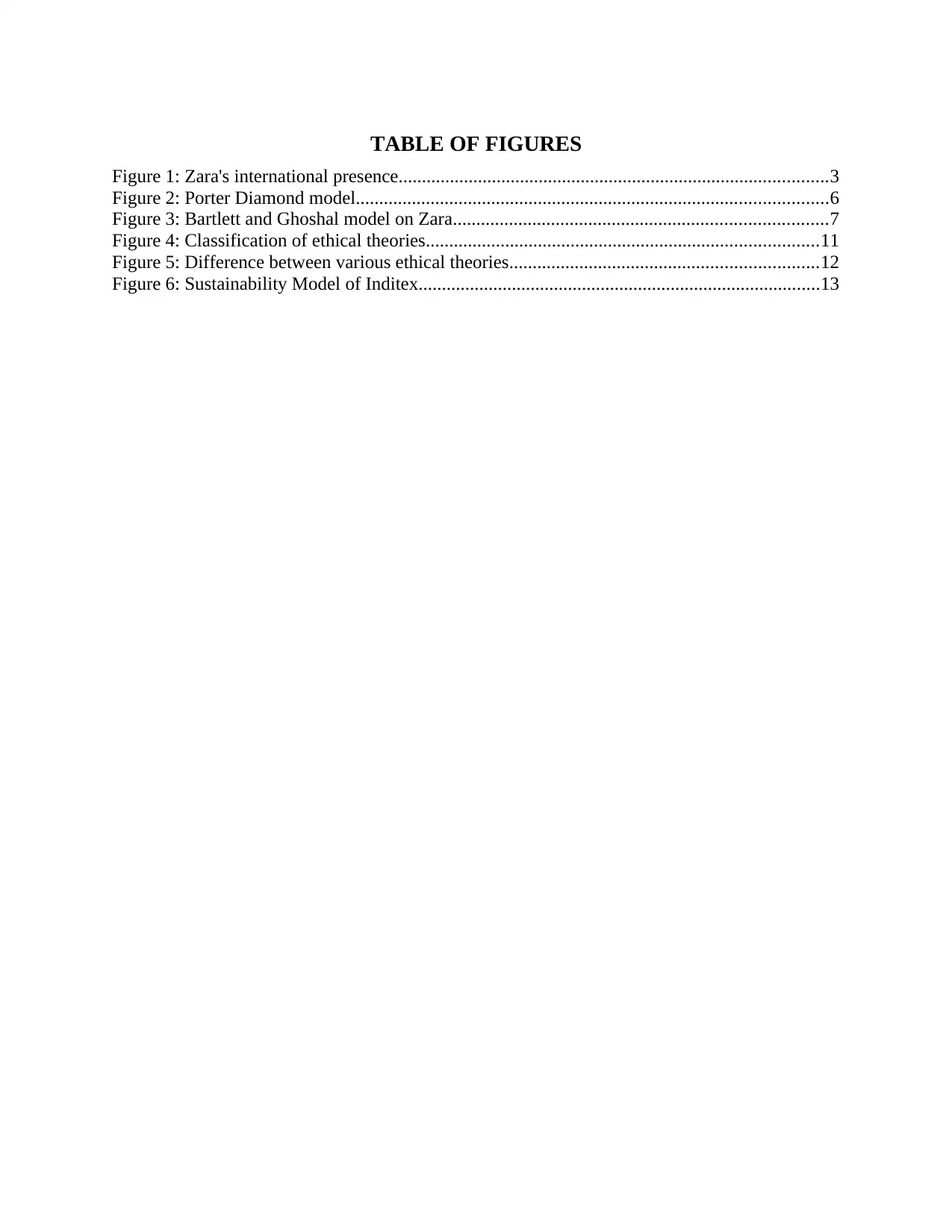
TABLE OF FIGURES
Figure 1: Zara's international presence............................................................................................3
Figure 2: Porter Diamond model.....................................................................................................6
Figure 3: Bartlett and Ghoshal model on Zara................................................................................7
Figure 4: Classification of ethical theories....................................................................................11
Figure 5: Difference between various ethical theories..................................................................12
Figure 6: Sustainability Model of Inditex......................................................................................13
Figure 1: Zara's international presence............................................................................................3
Figure 2: Porter Diamond model.....................................................................................................6
Figure 3: Bartlett and Ghoshal model on Zara................................................................................7
Figure 4: Classification of ethical theories....................................................................................11
Figure 5: Difference between various ethical theories..................................................................12
Figure 6: Sustainability Model of Inditex......................................................................................13
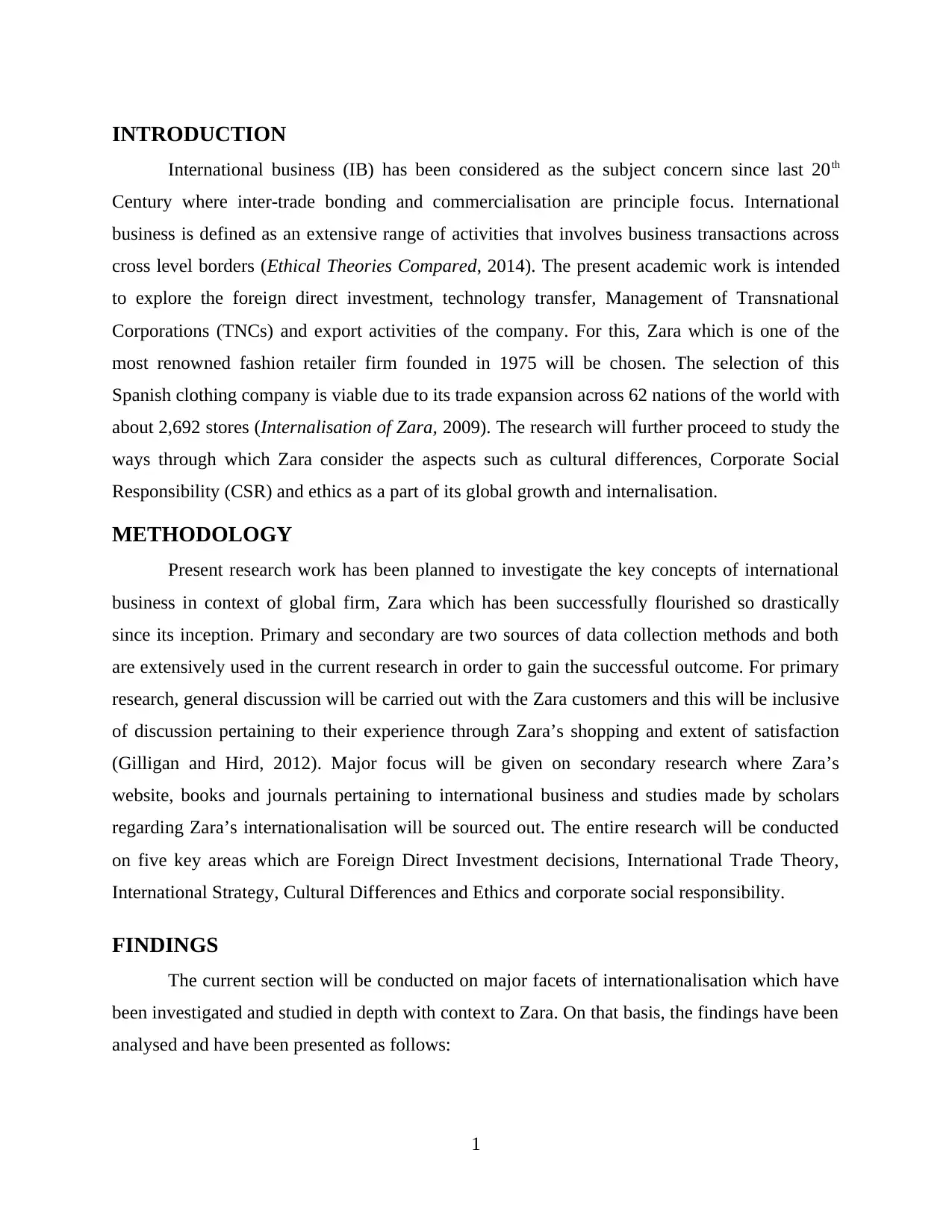
INTRODUCTION
International business (IB) has been considered as the subject concern since last 20th
Century where inter-trade bonding and commercialisation are principle focus. International
business is defined as an extensive range of activities that involves business transactions across
cross level borders (Ethical Theories Compared, 2014). The present academic work is intended
to explore the foreign direct investment, technology transfer, Management of Transnational
Corporations (TNCs) and export activities of the company. For this, Zara which is one of the
most renowned fashion retailer firm founded in 1975 will be chosen. The selection of this
Spanish clothing company is viable due to its trade expansion across 62 nations of the world with
about 2,692 stores (Internalisation of Zara, 2009). The research will further proceed to study the
ways through which Zara consider the aspects such as cultural differences, Corporate Social
Responsibility (CSR) and ethics as a part of its global growth and internalisation.
METHODOLOGY
Present research work has been planned to investigate the key concepts of international
business in context of global firm, Zara which has been successfully flourished so drastically
since its inception. Primary and secondary are two sources of data collection methods and both
are extensively used in the current research in order to gain the successful outcome. For primary
research, general discussion will be carried out with the Zara customers and this will be inclusive
of discussion pertaining to their experience through Zara’s shopping and extent of satisfaction
(Gilligan and Hird, 2012). Major focus will be given on secondary research where Zara’s
website, books and journals pertaining to international business and studies made by scholars
regarding Zara’s internationalisation will be sourced out. The entire research will be conducted
on five key areas which are Foreign Direct Investment decisions, International Trade Theory,
International Strategy, Cultural Differences and Ethics and corporate social responsibility.
FINDINGS
The current section will be conducted on major facets of internationalisation which have
been investigated and studied in depth with context to Zara. On that basis, the findings have been
analysed and have been presented as follows:
1
International business (IB) has been considered as the subject concern since last 20th
Century where inter-trade bonding and commercialisation are principle focus. International
business is defined as an extensive range of activities that involves business transactions across
cross level borders (Ethical Theories Compared, 2014). The present academic work is intended
to explore the foreign direct investment, technology transfer, Management of Transnational
Corporations (TNCs) and export activities of the company. For this, Zara which is one of the
most renowned fashion retailer firm founded in 1975 will be chosen. The selection of this
Spanish clothing company is viable due to its trade expansion across 62 nations of the world with
about 2,692 stores (Internalisation of Zara, 2009). The research will further proceed to study the
ways through which Zara consider the aspects such as cultural differences, Corporate Social
Responsibility (CSR) and ethics as a part of its global growth and internalisation.
METHODOLOGY
Present research work has been planned to investigate the key concepts of international
business in context of global firm, Zara which has been successfully flourished so drastically
since its inception. Primary and secondary are two sources of data collection methods and both
are extensively used in the current research in order to gain the successful outcome. For primary
research, general discussion will be carried out with the Zara customers and this will be inclusive
of discussion pertaining to their experience through Zara’s shopping and extent of satisfaction
(Gilligan and Hird, 2012). Major focus will be given on secondary research where Zara’s
website, books and journals pertaining to international business and studies made by scholars
regarding Zara’s internationalisation will be sourced out. The entire research will be conducted
on five key areas which are Foreign Direct Investment decisions, International Trade Theory,
International Strategy, Cultural Differences and Ethics and corporate social responsibility.
FINDINGS
The current section will be conducted on major facets of internationalisation which have
been investigated and studied in depth with context to Zara. On that basis, the findings have been
analysed and have been presented as follows:
1
⊘ This is a preview!⊘
Do you want full access?
Subscribe today to unlock all pages.

Trusted by 1+ million students worldwide
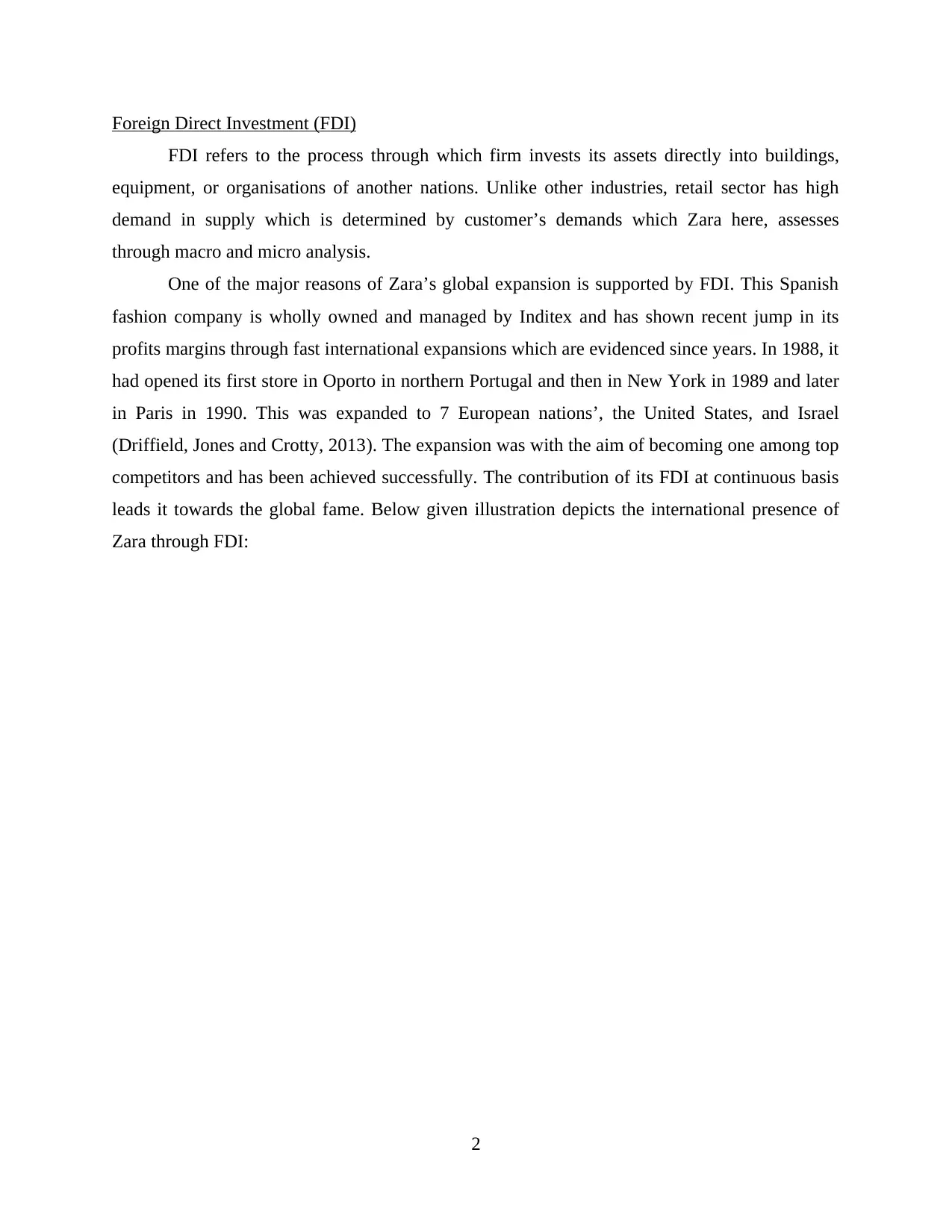
Foreign Direct Investment (FDI)
FDI refers to the process through which firm invests its assets directly into buildings,
equipment, or organisations of another nations. Unlike other industries, retail sector has high
demand in supply which is determined by customer’s demands which Zara here, assesses
through macro and micro analysis.
One of the major reasons of Zara’s global expansion is supported by FDI. This Spanish
fashion company is wholly owned and managed by Inditex and has shown recent jump in its
profits margins through fast international expansions which are evidenced since years. In 1988, it
had opened its first store in Oporto in northern Portugal and then in New York in 1989 and later
in Paris in 1990. This was expanded to 7 European nations’, the United States, and Israel
(Driffield, Jones and Crotty, 2013). The expansion was with the aim of becoming one among top
competitors and has been achieved successfully. The contribution of its FDI at continuous basis
leads it towards the global fame. Below given illustration depicts the international presence of
Zara through FDI:
2
FDI refers to the process through which firm invests its assets directly into buildings,
equipment, or organisations of another nations. Unlike other industries, retail sector has high
demand in supply which is determined by customer’s demands which Zara here, assesses
through macro and micro analysis.
One of the major reasons of Zara’s global expansion is supported by FDI. This Spanish
fashion company is wholly owned and managed by Inditex and has shown recent jump in its
profits margins through fast international expansions which are evidenced since years. In 1988, it
had opened its first store in Oporto in northern Portugal and then in New York in 1989 and later
in Paris in 1990. This was expanded to 7 European nations’, the United States, and Israel
(Driffield, Jones and Crotty, 2013). The expansion was with the aim of becoming one among top
competitors and has been achieved successfully. The contribution of its FDI at continuous basis
leads it towards the global fame. Below given illustration depicts the international presence of
Zara through FDI:
2
Paraphrase This Document
Need a fresh take? Get an instant paraphrase of this document with our AI Paraphraser
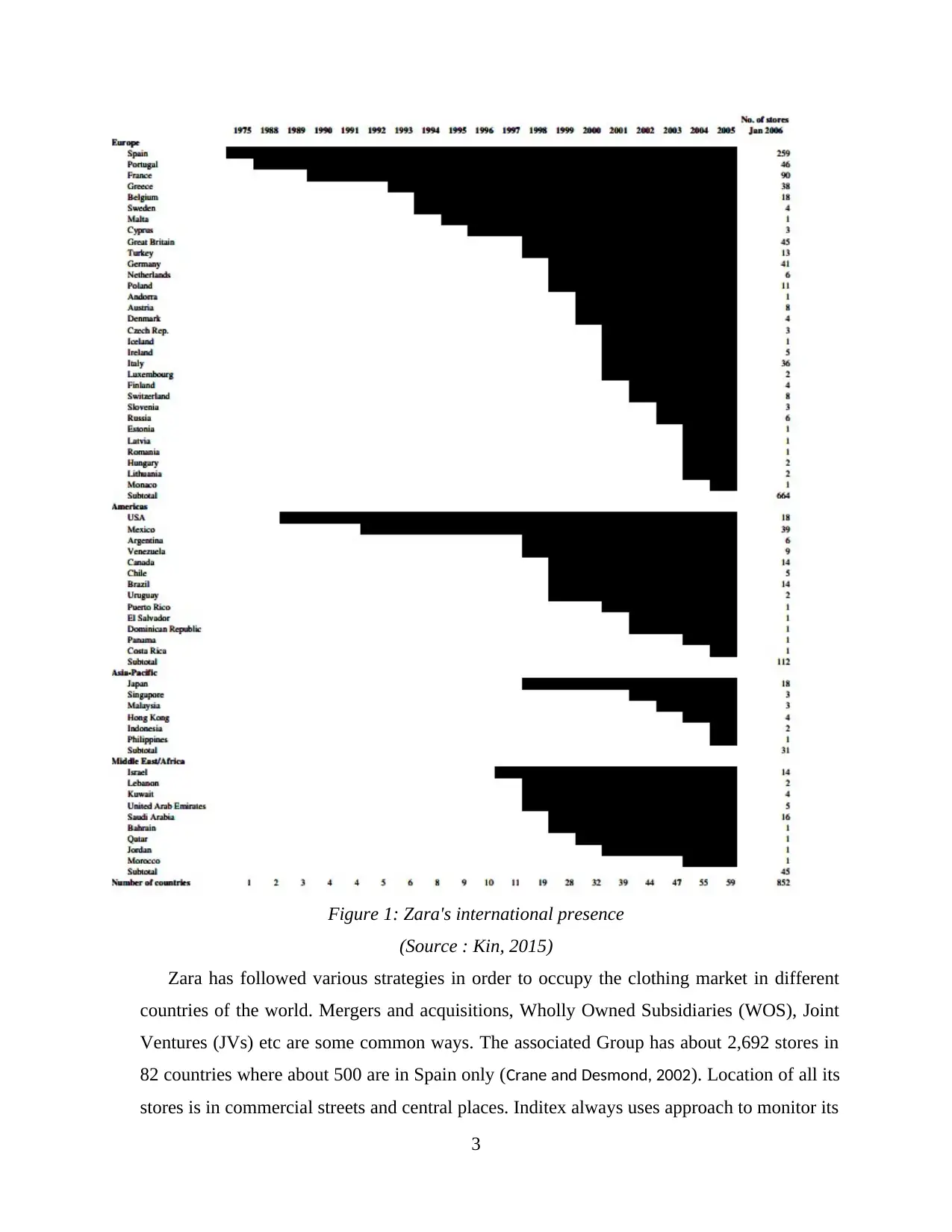
Figure 1: Zara's international presence
(Source : Kin, 2015)
Zara has followed various strategies in order to occupy the clothing market in different
countries of the world. Mergers and acquisitions, Wholly Owned Subsidiaries (WOS), Joint
Ventures (JVs) etc are some common ways. The associated Group has about 2,692 stores in
82 countries where about 500 are in Spain only (Crane and Desmond, 2002). Location of all its
stores is in commercial streets and central places. Inditex always uses approach to monitor its
3
(Source : Kin, 2015)
Zara has followed various strategies in order to occupy the clothing market in different
countries of the world. Mergers and acquisitions, Wholly Owned Subsidiaries (WOS), Joint
Ventures (JVs) etc are some common ways. The associated Group has about 2,692 stores in
82 countries where about 500 are in Spain only (Crane and Desmond, 2002). Location of all its
stores is in commercial streets and central places. Inditex always uses approach to monitor its
3
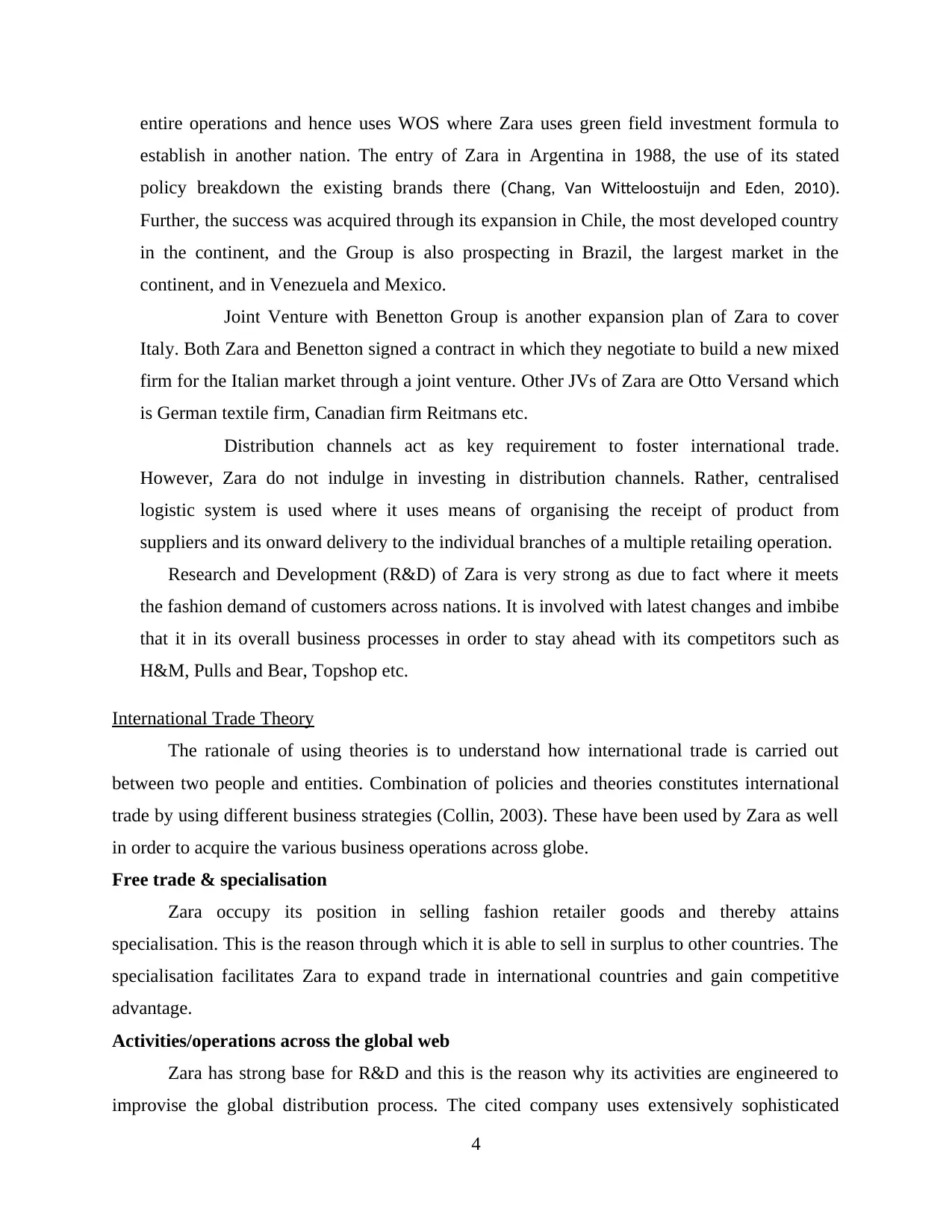
entire operations and hence uses WOS where Zara uses green field investment formula to
establish in another nation. The entry of Zara in Argentina in 1988, the use of its stated
policy breakdown the existing brands there (Chang, Van Witteloostuijn and Eden, 2010).
Further, the success was acquired through its expansion in Chile, the most developed country
in the continent, and the Group is also prospecting in Brazil, the largest market in the
continent, and in Venezuela and Mexico.
Joint Venture with Benetton Group is another expansion plan of Zara to cover
Italy. Both Zara and Benetton signed a contract in which they negotiate to build a new mixed
firm for the Italian market through a joint venture. Other JVs of Zara are Otto Versand which
is German textile firm, Canadian firm Reitmans etc.
Distribution channels act as key requirement to foster international trade.
However, Zara do not indulge in investing in distribution channels. Rather, centralised
logistic system is used where it uses means of organising the receipt of product from
suppliers and its onward delivery to the individual branches of a multiple retailing operation.
Research and Development (R&D) of Zara is very strong as due to fact where it meets
the fashion demand of customers across nations. It is involved with latest changes and imbibe
that it in its overall business processes in order to stay ahead with its competitors such as
H&M, Pulls and Bear, Topshop etc.
International Trade Theory
The rationale of using theories is to understand how international trade is carried out
between two people and entities. Combination of policies and theories constitutes international
trade by using different business strategies (Collin, 2003). These have been used by Zara as well
in order to acquire the various business operations across globe.
Free trade & specialisation
Zara occupy its position in selling fashion retailer goods and thereby attains
specialisation. This is the reason through which it is able to sell in surplus to other countries. The
specialisation facilitates Zara to expand trade in international countries and gain competitive
advantage.
Activities/operations across the global web
Zara has strong base for R&D and this is the reason why its activities are engineered to
improvise the global distribution process. The cited company uses extensively sophisticated
4
establish in another nation. The entry of Zara in Argentina in 1988, the use of its stated
policy breakdown the existing brands there (Chang, Van Witteloostuijn and Eden, 2010).
Further, the success was acquired through its expansion in Chile, the most developed country
in the continent, and the Group is also prospecting in Brazil, the largest market in the
continent, and in Venezuela and Mexico.
Joint Venture with Benetton Group is another expansion plan of Zara to cover
Italy. Both Zara and Benetton signed a contract in which they negotiate to build a new mixed
firm for the Italian market through a joint venture. Other JVs of Zara are Otto Versand which
is German textile firm, Canadian firm Reitmans etc.
Distribution channels act as key requirement to foster international trade.
However, Zara do not indulge in investing in distribution channels. Rather, centralised
logistic system is used where it uses means of organising the receipt of product from
suppliers and its onward delivery to the individual branches of a multiple retailing operation.
Research and Development (R&D) of Zara is very strong as due to fact where it meets
the fashion demand of customers across nations. It is involved with latest changes and imbibe
that it in its overall business processes in order to stay ahead with its competitors such as
H&M, Pulls and Bear, Topshop etc.
International Trade Theory
The rationale of using theories is to understand how international trade is carried out
between two people and entities. Combination of policies and theories constitutes international
trade by using different business strategies (Collin, 2003). These have been used by Zara as well
in order to acquire the various business operations across globe.
Free trade & specialisation
Zara occupy its position in selling fashion retailer goods and thereby attains
specialisation. This is the reason through which it is able to sell in surplus to other countries. The
specialisation facilitates Zara to expand trade in international countries and gain competitive
advantage.
Activities/operations across the global web
Zara has strong base for R&D and this is the reason why its activities are engineered to
improvise the global distribution process. The cited company uses extensively sophisticated
4
⊘ This is a preview!⊘
Do you want full access?
Subscribe today to unlock all pages.

Trusted by 1+ million students worldwide
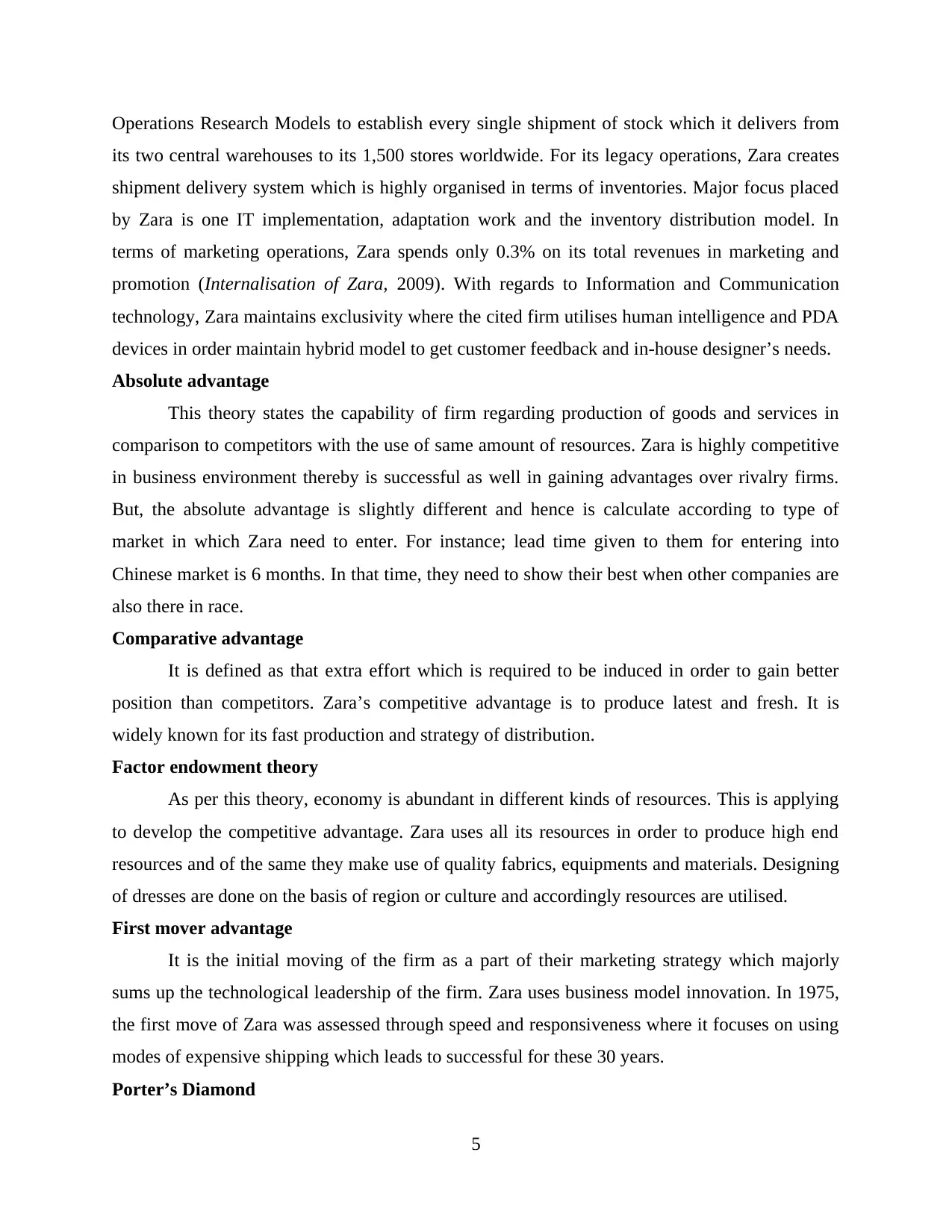
Operations Research Models to establish every single shipment of stock which it delivers from
its two central warehouses to its 1,500 stores worldwide. For its legacy operations, Zara creates
shipment delivery system which is highly organised in terms of inventories. Major focus placed
by Zara is one IT implementation, adaptation work and the inventory distribution model. In
terms of marketing operations, Zara spends only 0.3% on its total revenues in marketing and
promotion (Internalisation of Zara, 2009). With regards to Information and Communication
technology, Zara maintains exclusivity where the cited firm utilises human intelligence and PDA
devices in order maintain hybrid model to get customer feedback and in-house designer’s needs.
Absolute advantage
This theory states the capability of firm regarding production of goods and services in
comparison to competitors with the use of same amount of resources. Zara is highly competitive
in business environment thereby is successful as well in gaining advantages over rivalry firms.
But, the absolute advantage is slightly different and hence is calculate according to type of
market in which Zara need to enter. For instance; lead time given to them for entering into
Chinese market is 6 months. In that time, they need to show their best when other companies are
also there in race.
Comparative advantage
It is defined as that extra effort which is required to be induced in order to gain better
position than competitors. Zara’s competitive advantage is to produce latest and fresh. It is
widely known for its fast production and strategy of distribution.
Factor endowment theory
As per this theory, economy is abundant in different kinds of resources. This is applying
to develop the competitive advantage. Zara uses all its resources in order to produce high end
resources and of the same they make use of quality fabrics, equipments and materials. Designing
of dresses are done on the basis of region or culture and accordingly resources are utilised.
First mover advantage
It is the initial moving of the firm as a part of their marketing strategy which majorly
sums up the technological leadership of the firm. Zara uses business model innovation. In 1975,
the first move of Zara was assessed through speed and responsiveness where it focuses on using
modes of expensive shipping which leads to successful for these 30 years.
Porter’s Diamond
5
its two central warehouses to its 1,500 stores worldwide. For its legacy operations, Zara creates
shipment delivery system which is highly organised in terms of inventories. Major focus placed
by Zara is one IT implementation, adaptation work and the inventory distribution model. In
terms of marketing operations, Zara spends only 0.3% on its total revenues in marketing and
promotion (Internalisation of Zara, 2009). With regards to Information and Communication
technology, Zara maintains exclusivity where the cited firm utilises human intelligence and PDA
devices in order maintain hybrid model to get customer feedback and in-house designer’s needs.
Absolute advantage
This theory states the capability of firm regarding production of goods and services in
comparison to competitors with the use of same amount of resources. Zara is highly competitive
in business environment thereby is successful as well in gaining advantages over rivalry firms.
But, the absolute advantage is slightly different and hence is calculate according to type of
market in which Zara need to enter. For instance; lead time given to them for entering into
Chinese market is 6 months. In that time, they need to show their best when other companies are
also there in race.
Comparative advantage
It is defined as that extra effort which is required to be induced in order to gain better
position than competitors. Zara’s competitive advantage is to produce latest and fresh. It is
widely known for its fast production and strategy of distribution.
Factor endowment theory
As per this theory, economy is abundant in different kinds of resources. This is applying
to develop the competitive advantage. Zara uses all its resources in order to produce high end
resources and of the same they make use of quality fabrics, equipments and materials. Designing
of dresses are done on the basis of region or culture and accordingly resources are utilised.
First mover advantage
It is the initial moving of the firm as a part of their marketing strategy which majorly
sums up the technological leadership of the firm. Zara uses business model innovation. In 1975,
the first move of Zara was assessed through speed and responsiveness where it focuses on using
modes of expensive shipping which leads to successful for these 30 years.
Porter’s Diamond
5
Paraphrase This Document
Need a fresh take? Get an instant paraphrase of this document with our AI Paraphraser
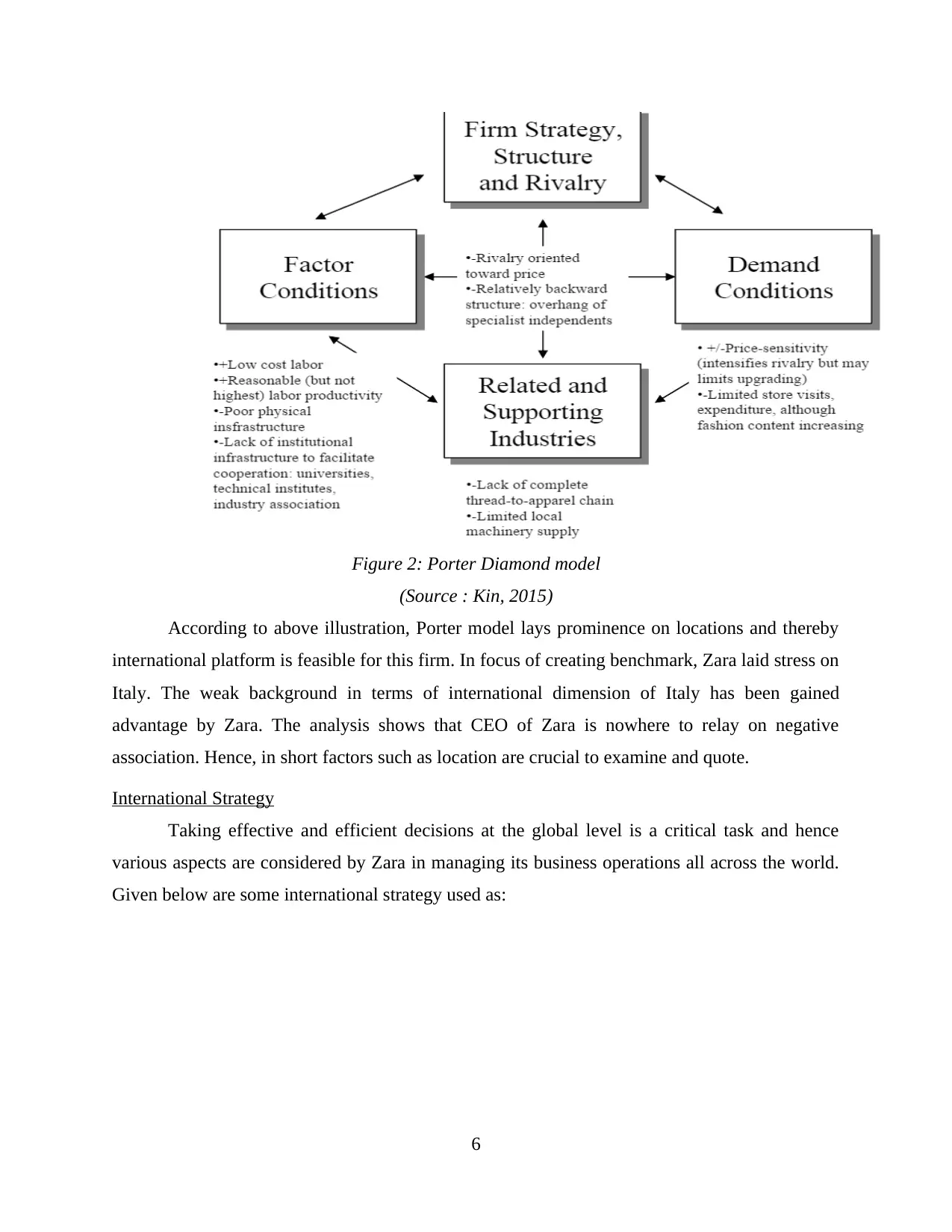
Figure 2: Porter Diamond model
(Source : Kin, 2015)
According to above illustration, Porter model lays prominence on locations and thereby
international platform is feasible for this firm. In focus of creating benchmark, Zara laid stress on
Italy. The weak background in terms of international dimension of Italy has been gained
advantage by Zara. The analysis shows that CEO of Zara is nowhere to relay on negative
association. Hence, in short factors such as location are crucial to examine and quote.
International Strategy
Taking effective and efficient decisions at the global level is a critical task and hence
various aspects are considered by Zara in managing its business operations all across the world.
Given below are some international strategy used as:
6
(Source : Kin, 2015)
According to above illustration, Porter model lays prominence on locations and thereby
international platform is feasible for this firm. In focus of creating benchmark, Zara laid stress on
Italy. The weak background in terms of international dimension of Italy has been gained
advantage by Zara. The analysis shows that CEO of Zara is nowhere to relay on negative
association. Hence, in short factors such as location are crucial to examine and quote.
International Strategy
Taking effective and efficient decisions at the global level is a critical task and hence
various aspects are considered by Zara in managing its business operations all across the world.
Given below are some international strategy used as:
6
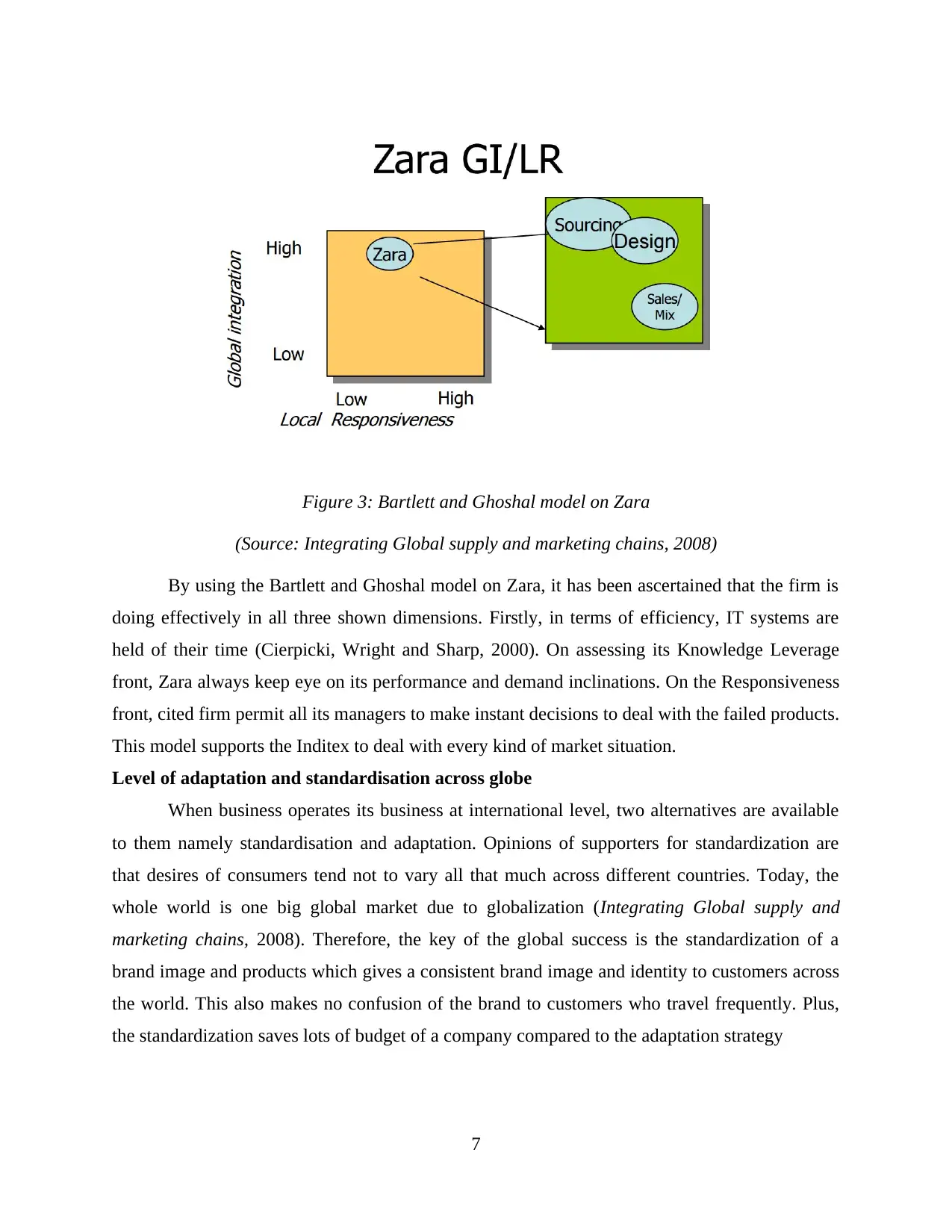
Figure 3: Bartlett and Ghoshal model on Zara
(Source: Integrating Global supply and marketing chains, 2008)
By using the Bartlett and Ghoshal model on Zara, it has been ascertained that the firm is
doing effectively in all three shown dimensions. Firstly, in terms of efficiency, IT systems are
held of their time (Cierpicki, Wright and Sharp, 2000). On assessing its Knowledge Leverage
front, Zara always keep eye on its performance and demand inclinations. On the Responsiveness
front, cited firm permit all its managers to make instant decisions to deal with the failed products.
This model supports the Inditex to deal with every kind of market situation.
Level of adaptation and standardisation across globe
When business operates its business at international level, two alternatives are available
to them namely standardisation and adaptation. Opinions of supporters for standardization are
that desires of consumers tend not to vary all that much across different countries. Today, the
whole world is one big global market due to globalization (Integrating Global supply and
marketing chains, 2008). Therefore, the key of the global success is the standardization of a
brand image and products which gives a consistent brand image and identity to customers across
the world. This also makes no confusion of the brand to customers who travel frequently. Plus,
the standardization saves lots of budget of a company compared to the adaptation strategy
7
(Source: Integrating Global supply and marketing chains, 2008)
By using the Bartlett and Ghoshal model on Zara, it has been ascertained that the firm is
doing effectively in all three shown dimensions. Firstly, in terms of efficiency, IT systems are
held of their time (Cierpicki, Wright and Sharp, 2000). On assessing its Knowledge Leverage
front, Zara always keep eye on its performance and demand inclinations. On the Responsiveness
front, cited firm permit all its managers to make instant decisions to deal with the failed products.
This model supports the Inditex to deal with every kind of market situation.
Level of adaptation and standardisation across globe
When business operates its business at international level, two alternatives are available
to them namely standardisation and adaptation. Opinions of supporters for standardization are
that desires of consumers tend not to vary all that much across different countries. Today, the
whole world is one big global market due to globalization (Integrating Global supply and
marketing chains, 2008). Therefore, the key of the global success is the standardization of a
brand image and products which gives a consistent brand image and identity to customers across
the world. This also makes no confusion of the brand to customers who travel frequently. Plus,
the standardization saves lots of budget of a company compared to the adaptation strategy
7
⊘ This is a preview!⊘
Do you want full access?
Subscribe today to unlock all pages.

Trusted by 1+ million students worldwide
1 out of 20
Related Documents
Your All-in-One AI-Powered Toolkit for Academic Success.
+13062052269
info@desklib.com
Available 24*7 on WhatsApp / Email
![[object Object]](/_next/static/media/star-bottom.7253800d.svg)
Unlock your academic potential
Copyright © 2020–2025 A2Z Services. All Rights Reserved. Developed and managed by ZUCOL.





